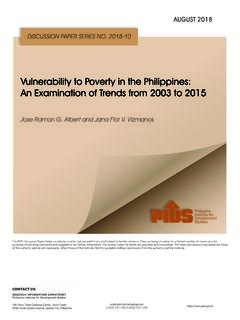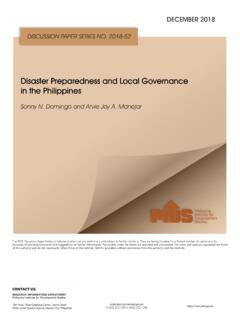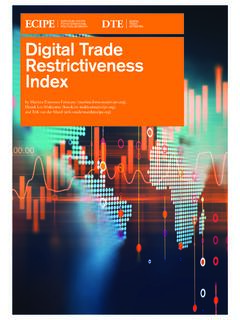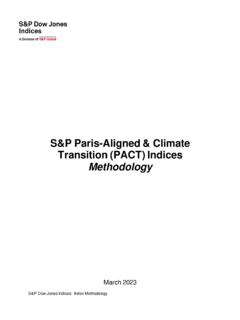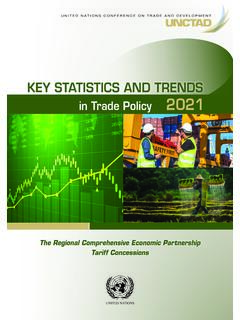Transcription of Regulatory challenges in the Philippine logistics industry
1 ISSN 2508-0865 (electronic) No. 2018-01 (March 2018). Regulatory challenges in the Philippine logistics industry Jose L. Tongzon logistics plays a significant role in a nation's economic et al. 2000; De Sousa and Findlay 2007; Hollweg development (Radelet and Sachs 1998; Hummels and Wong 2009; Anderson and Banomyong 2010;. 1999; Lim o and Venables 2001; Wilson et al. 2003). Tongzon 2011; Tongzon 2012; Tongzon et al. 2017). An ef cient logistics sector contributes to trade For instance, Fink et al. (2000) attributed the performance and economic development by lowering differences in shipping costs mainly to the countries'. transaction costs and creating more customer value, restrictive trade policies and the anticompetitive thus providing rms with opportunities to increase their practices of liner shipping conferences. They earnings and enhance their competitiveness (Gannon added that the deregulation of trade measures, and Liu 1997; Banomyong et al.
2 2008). In this era particularly in the provision of port services, and of increasing globalization, the sector is gradually the breakup of anticompetitive shipping alliances becoming both a differentiating factor and a source of can substantially lower shipping costs (Fink et al. international competitiveness. However, it currently 2000). Meanwhile, Hollweg and Wong (2009) noted requires a Regulatory environment that encourages a negative relationship between logistics Regulatory rather than stifles efficiency and competitiveness. restrictiveness and logistics performance based on the World Bank's LPI. This Policy Note assesses the Philippine logistics industry by looking at its logistics performance index All these studies have also shown that an improved (LPI). It presents the good practices of Singapore that market access for logistic services can lead to our policymakers should consider in improving the greater efficiency and lower costs of logistics in the competitiveness of our local logistics sector.
3 Country. However, they have also pointed out that the deregulation of logistics services per se does Efficiency in logistics and restrictive regulations not necessarily lead to higher exports and greater Previous studies have established a link between economic growth. Instead, the deregulation should market access and efficiency in logistics (see Fink be coupled with the necessary reforms to improve the Due to its archipelagic nature and burdensome, way below those of Singapore, Malaysia, Thailand, and sometimes inconsistent, regulations, and Indonesia (Figure 1). The country even trails the Philippines currently has the highest behind Viet Nam, considered as one of ASEAN. logistics cost among the member-states of the transitional economies. Clearly, the local logistics Association of Southeast Asian Nations .. sector has a competitive disadvantage compared to Despite this, the Philippine logistics market its counterparts in other older (or original) ASEAN.)
4 Has still managed to grow as a result of the members. World Bank (2016) imputed this weak country's strong economic growth, growing performance to the country's inadequate and relatively outsourcing sector, and rising globalization. poor quality of infrastructure, inefficient customs, poor competency of its logistics providers, and their limited ability to track and trace shipments. country's capacity and international competitiveness. The excessive fees further worsen the standing of These reforms include the building of the needed the local logistics sector in the market. According infrastructure, the improvement of the Regulatory to the Maritime industry Authority (2016),1 the framework, and the implementation of policies that high logistics cost in the Philippines is due to the facilitate the transfer of technology from highly limited cargo base (lack of economies of scale), efficient foreign logistics firms to their less efficient inadequate port infrastructure, lack of competition local counterparts.
5 In the coastal shipping market due to cabotage, inadequate road transport networks and regulations logistics and the Philippine that lead to excessive road congestion, high cost of economic development port operations, and inadequate investments from the Due to its archipelagic nature and burdensome, and private sector. In terms of the lack of competition, sometimes inconsistent, regulations, the Philippines for instance, the local market for shipping has yet to currently has the highest logistics cost among the fully open to foreign shipping operators. In fact, only member-states of the Association of Southeast domestic ships are currently allowed to make port-to- Asian Nations (ASEAN) (DTI 2016). Despite this, the port calls within the country, thus constraining the Philippine logistics market has still managed to grow flow of cargoes throughout the logistics chain. as a result of the country's strong economic growth, growing outsourcing sector, and rising globalization Philippine and Singapore's styles (Ken Research Private Limited 2016).
6 Nonetheless, it of ports administration has remained fragmented and dominated by foreign transnational players (Tongzon 2011). Local logistics Philippines' PPA and CPA charters firms have also remained generally small to medium One factor behind the poor performance and low in size, compared to their foreign counterparts, and international competitiveness of the Philippine are mainly offering freight forwarding services (Ken logistics sector is its restrictive and incoherent Research Private Limited 2016). Regulatory framework, as can be seen in the case Based on the latest survey undertaken by the _____. World Bank (2016), the Philippine LPI in 2016 was 1. Personal interview with MARINA. 2 w Regulatory challenges in the Philippine logistics industry Figure 1. ASEAN (sans Brunei Darussalam) cross-country comparison in terms of logistics performance index Source: World Bank (2016). of the Philippine ports. The efficiency of the ports As such, both the PPA and the CPA act as regulators matters because their costs account for a large and port operators.
7 Given that they also have shares part of maritime transport costs, which providers in the revenue from their port operations,2 the and shippers usually shoulder by way of increased PPA and the CPA may tend to approve any rate or shipping charges. Delays due to port inefficiency can charge increases applied by the terminal operators also lead to higher inventory costs and even loss of and formulate policies and regulations that may be business opportunities. beneficial to the terminal operators, but could be detrimental to the interest of the logistics services Except for the Port of Cebu, which is under the Cebu providers and shippers. These situations then create Ports Authority (CPA), all Philippine public ports a conflict of interest, one of the major factors behind are under the responsibility of the Philippine Ports the high level of port inefficiency and exorbitant Authority (PPA). Based on the PPA Charter, the port charges (Basilio 2003).
8 Corollary to this is PPA has both operational and Regulatory functions. the fact that most ports in the country are under Meanwhile, the CPA Charter also equips the CPA with the management of the PPA. This situation leads Regulatory and operational functions over all ports in _____. the province of Cebu. 2. The entitlement of PPA to a share from cargo-handling revenues is stated under Letter of Instruction 1005-A. PIDS Policy Notes 2018-01 w 3. According to the World Bank, the Philippines is among the bottom four Southeast Asian countries on the 2016 logistics performance index . The organization imputed this weak performance to the country's inadequate and relatively poor quality of infrastructure, inefficient customs, poor competency of its logistics providers, and their limited ability to track and trace shipments. The excessive fees further worsen the standing of the local logistics sector in the market. This study urges the government to revisit the management and regulation of ports and enhance the private sector participation in the industry to improve its inefficiency and its international competitiveness.
9 (Photo: Gizelle Manuel). to lack of interport competition and thus lower of ports has become a growing trend among ports port efficiency. Although a somewhat centralized around the world in the past two decades administration of ports can help avert investment (WB 2001). One good example of this trend is duplication and excess capacity, it tends to create a Singapore's Maritime and Port Authority (MPA), less competitive port environment. equivalent to our Maritime industry Authority. The issue on conflict of interest is actually part of a To separate operational from Regulatory functions, broader concern regarding the government involvement the Singapore government established the MPA in in the management and operation of ports. Empirical 1996 through the merger of the Marine Department, evidence, for instance, leans toward limiting the the National Maritime Board, and the Regulatory government involvement in the regulation of ports to departments of the former Port of Singapore Authority ensure their efficiency (Tongzon and Heng 2005).
10 (PSA). Since then, the main job of MPA has been to regulate the port and shipping activities in Singapore. Singapore's Maritime and Port Authority Meanwhile, the PSA has been tasked to manage and The separation of Regulatory and operational functions run the ports. 4 w Regulatory challenges in the Philippine logistics industry The PSA was subsequently corporatized to enhance Ports can also be considered as a public good its flexibility and responsiveness to business with substantial positive economic externalities opportunities. Prior the said corporatization, the that cannot be left to the profit-oriented private commercial operations and Regulatory functions sector. Under this concept, a port does not have were under the responsibility of Singapore's state- to be profitable or efficient as long as it provides owned PSA. a vital service and contributes to the economic development of a country by facilitating A cautionary note international trade and providing a vital link Less government involvement in the port management between various regions in the country.


